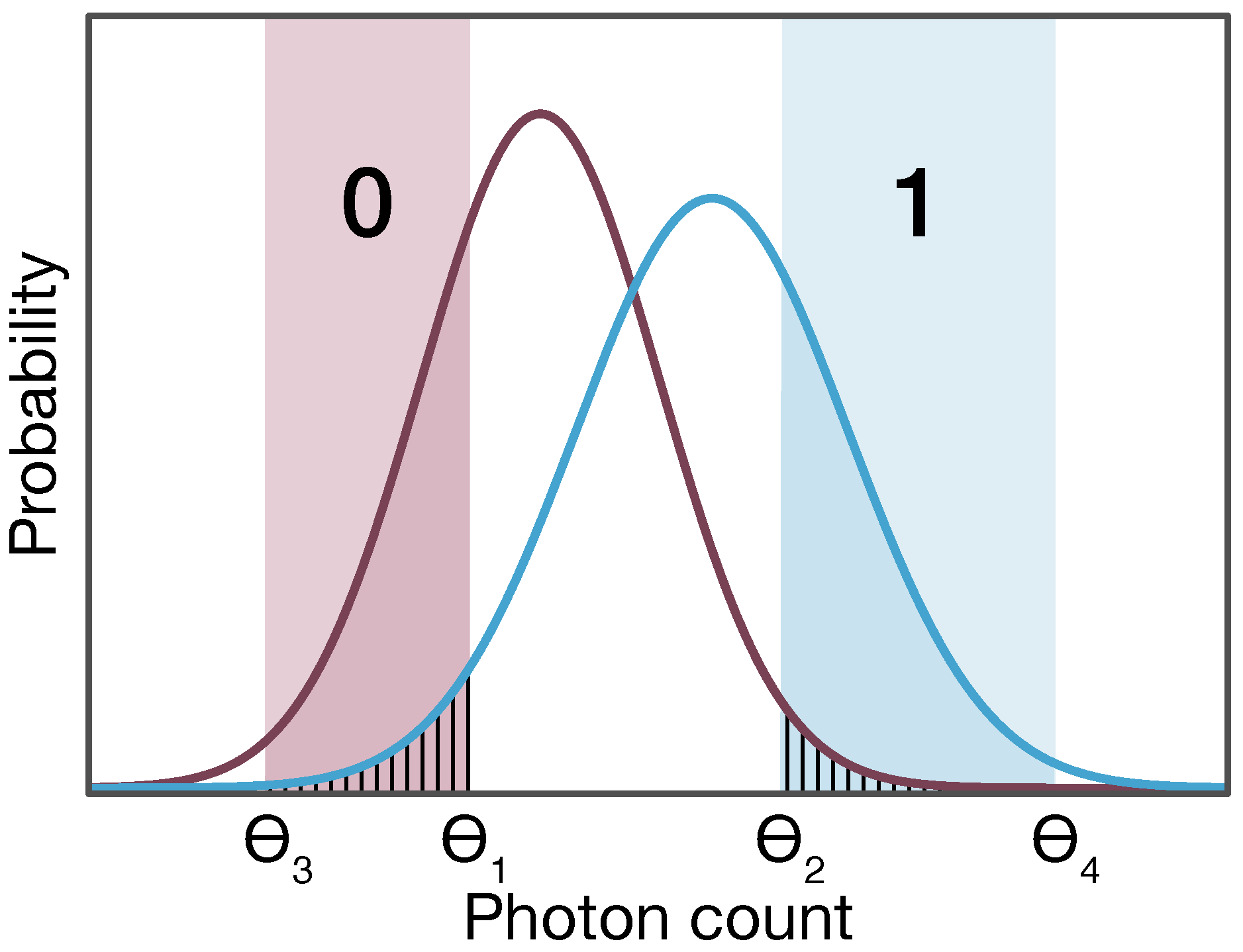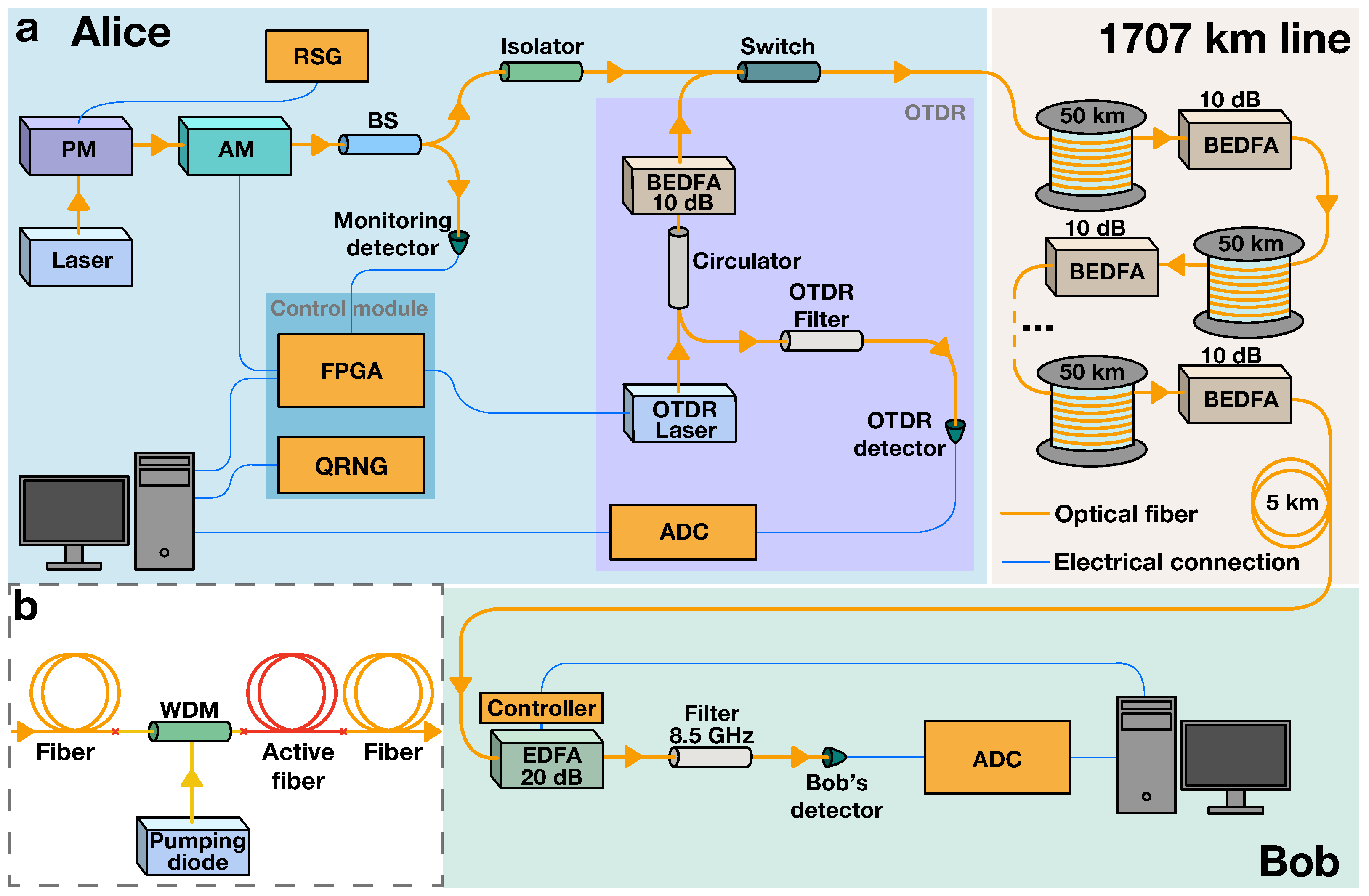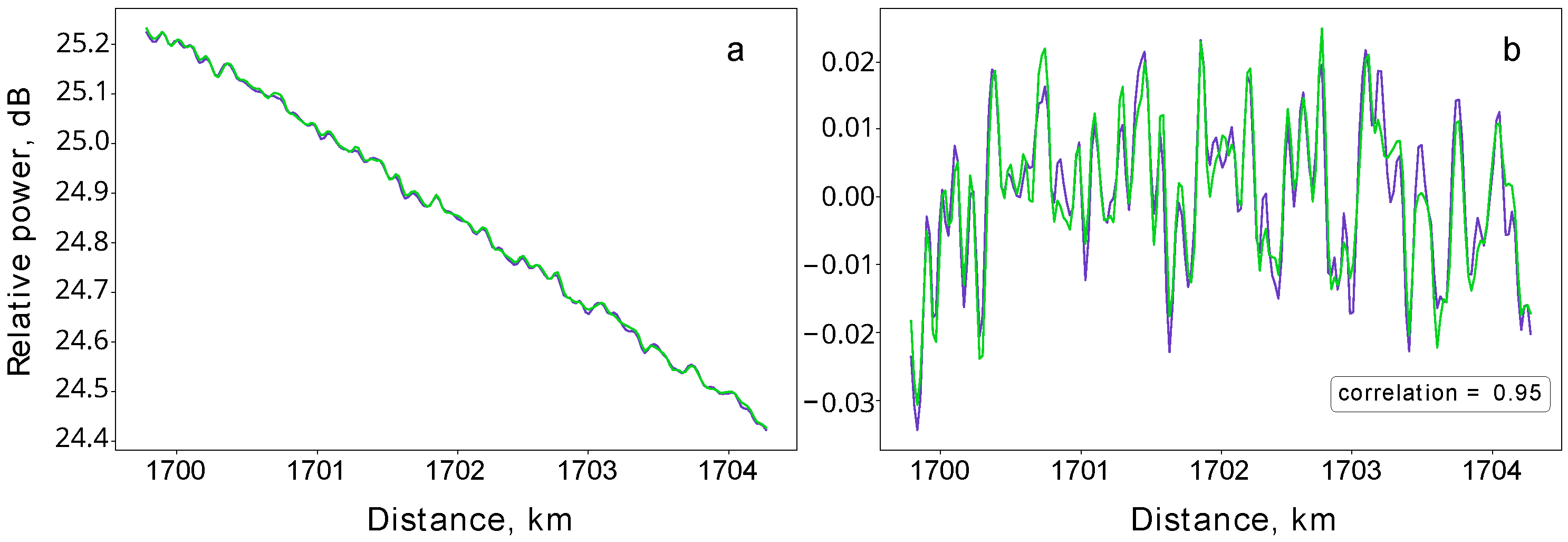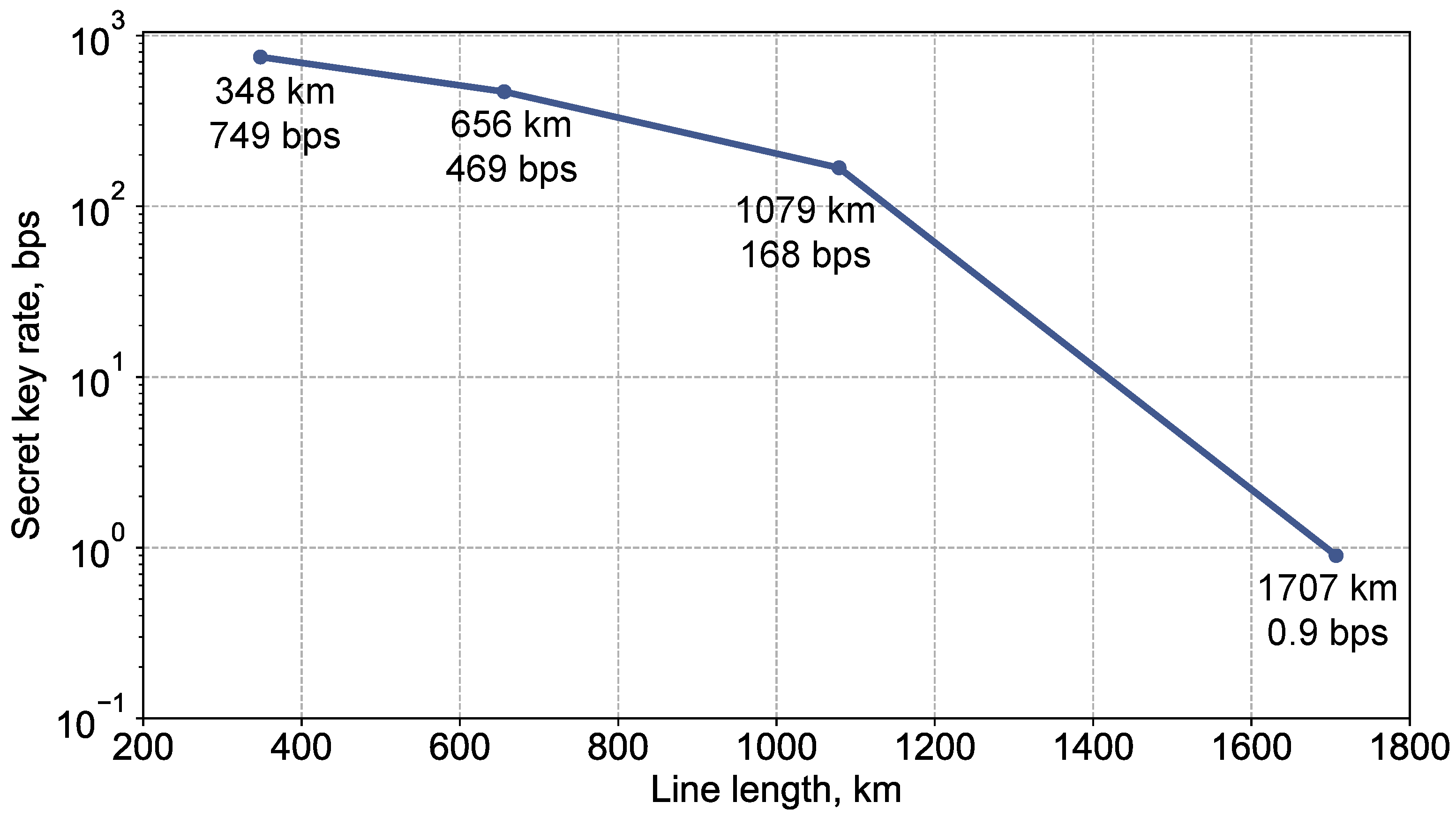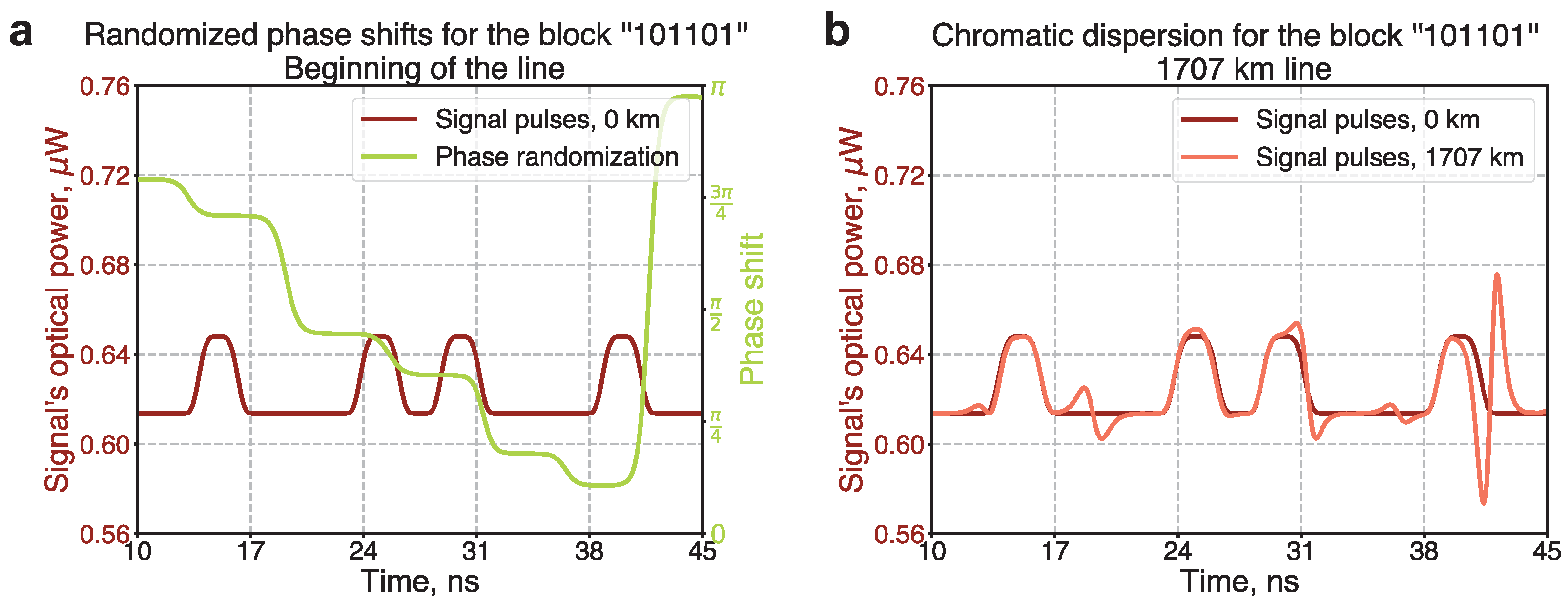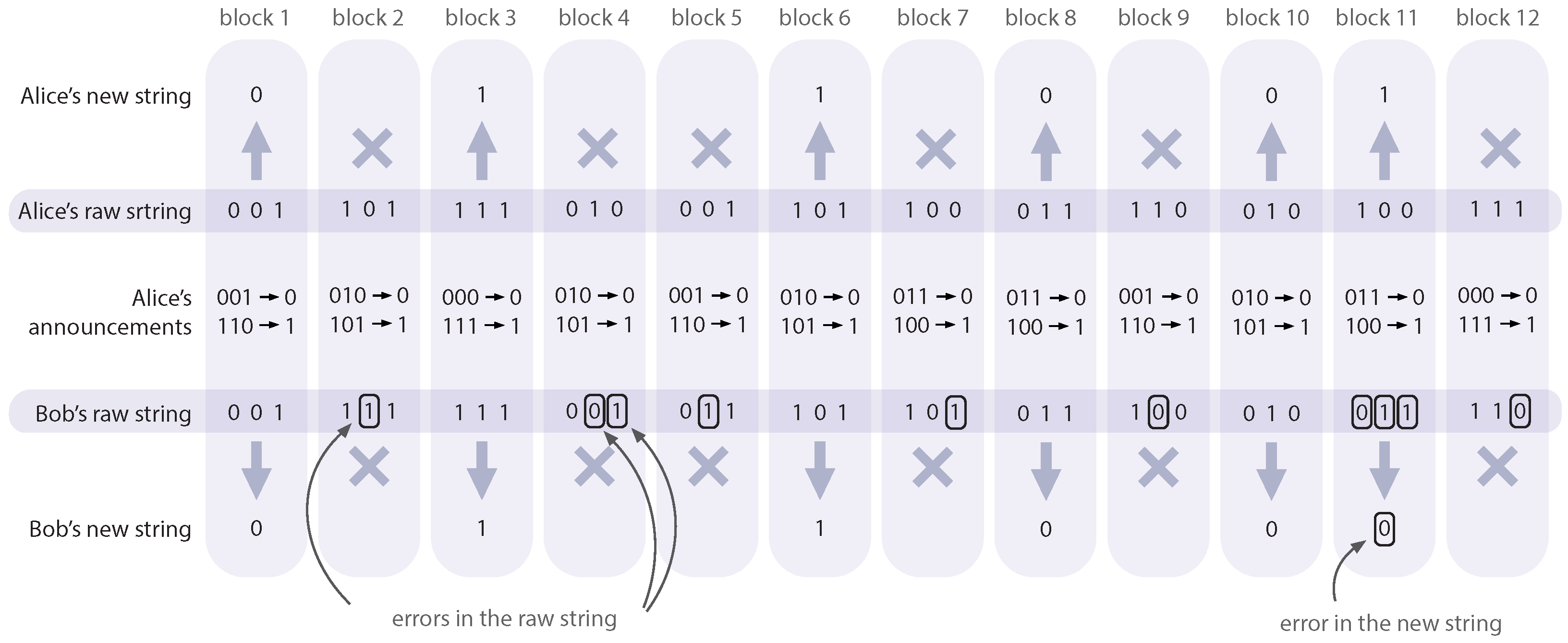1. Introduction
Quantum cryptography promising information transmission invulnerable to cyber threats stands at the forefront of a new era in secure communication. One of the major challenges here is the development of methods allowing for high-rate quantum communication over long distances. In real lossy quantum channels, particularly in the fiber-optic lines, transmissivity drops exponentially with distance, severely limiting the communication range. Despite this obstacle, remarkable progress has been achieved in extending quantum communication distances to hundreds and even a thousand kilometers [
1]. Notable milestones in quantum communication include advancements in quantum one-time programs [
2,
3], quantum secure direct communication [
4], the twin-field technique [
1,
5], measurement-device-independent quantum communication [
6], satellite-based communication [
7], and the time-bin technique [
8,
9]. Another possible way of extending transmission distances is the use of quantum repeaters [
10,
11,
12,
13,
14,
15], which are based on utilizing the quantum entanglement resource.
Recent theoretical papers [
16,
17] have established an alternative approach to overcoming the distance limitations of key distribution, which has later been realized experimentally [
18]. The developed Quantum-Protected Control-Based Key Distribution (QCKD) follows the prepare-and-measure logics in the optical setting. In this protocol, the bits 0 and 1 are represented by the coherent states
and
. The central idea is that the legitimate users Alice and Bob monitor the local signal leakages within the transmission channel, a fiber-optic line, and ensure that the leaked states—potentially captured by an eavesdropper, Eve—are substantially non-orthogonal. If the proportion of the leaked signal is
, then
, and as this scalar product closely approaches 1, the information accessible to Eve, constrained by the Holevo bound [
19], goes to zero. As long as the leakage remains below a certain threshold, the users maintain an informational advantage over Eve, ensuring the safe distribution of the secret key. Importantly, given that the employed coherent states’ intensities,
and
, are sufficiently low, eavesdropping on the homogeneously distributed Rayleigh scattering is unfeasible [
16]. With that, the signal states can have sufficient intensities to be transmitted across a long fiber line containing optical amplifiers.
Here, we present the experimental realization of the QCKD protocol effectively working in a 1707 km long optical line. Our experimental settings include, in particular, specially designed bidirectional erbium-doped fiber amplifiers (BEDFAs) and a robust loss control apparatus. We show the precision and effectiveness of the loss control based on optical time-domain reflectometry (OTDR) [
20,
21]. As compared to [
18], where experiments with a 1079 km line were reported, this study not only extends the protocol’s range but also addresses the impacts of statistical fluctuations and technical noise on the key distribution rate. Furthermore, here we demonstrate that the application of advantage distillation in the QCKD, which increases the system’s tolerance to errors, allowing for the accommodation of larger signal losses over longer transmission distances. Finally, we present the experimental results of the key distribution over various distances, including 1707 km. In addition, we discuss the possibility of expanding the QCKD to a multi-user network.
2. Description of the QCKD
In this section, we outline the implemented QCKD protocol, which is a modified version of the protocol described in detail in Ref. [
16]. The protocol utilizes an optical fiber line for the transmission of quantum states and a classical authenticated channel for the exchange of service information.
Before beginning the main steps of the protocol, the users must complete an initialization phase. During this phase, and only during this phase, the users must be sure that the fiber line is secure against any unauthorized access or intervention by Eve. For instance, this phase may take place before deploying the fiber in the field. At this stage, the users establish the initial loss profile of the line by the OTDR method, which is widely used to assess the integrity of fiber lines, especially in the absence of optical amplifiers. The OTDR uses Rayleigh scattering as an instrument in detecting any new leakages that may arise along the fiber-optic line. The core principle involves transmitting a high-intensity probing pulse into the optical fiber, and then, measuring the power of the light that is backscattered to the source. This measurement records the distance to the corresponding scattering point, which is determined based on the time it takes for the light to return. Any newly occurring leakage changes the power of the backscattered radiation from the OTDR probing pulse. Specifically, the backscattered power decreases in the segment of the fiber where the eavesdropping intervention is located. The collected data from this process are represented in a reflectogram, which is a log-linear plot that depicts the backscattered power as a function of distance along the fiber.
Natural homogeneous losses, resulting from Rayleigh scattering due to density fluctuations in the fiber, cannot be effectively exploited by Eve, as described in detail in Ref. [
16], and are considered as non-compromised losses. Conversely, localized losses, which occur at optical connections, splices, or bends where the signal can leak, can be eavesdropped. These losses must be either assumed to be compromised by Eve (and the users must take these losses into account in their evaluation of Eve’s information for the subsequent privacy amplification stage discussed below) or must be reduced by avoiding physical connectors and eliminating bends in the fiber. Our experimental analysis shows that losses at splice joints are minimal, around 0.1%, which is acceptable. Nevertheless, the use of continuous fiber without connections or splice joints further reduces the leakage.
In addition to assessing and pinpointing the losses, the OTDR also generates a unique fingerprint of the line. Given that quenched disorder within the fiber acts as a physically unclonable function, its corresponding reflectogram cannot be duplicated. Consequently, any interference into the fiber would alter this fingerprint, and thus, will be detectable [
22]. The reflectogram obtained during initialization serves as the baseline fingerprint, allowing for the users to periodically use the OTDR for comparisons.
The main steps of the protocol are depicted in
Figure 1. The protocol starts with the OTDR scan, but this time, the users no longer need to ensure that Eve is absent. The inferred reflectogram is compared with the initial one. If the users observe a significant alteration in the line’s reflectogram, the protocol must be terminated, and the corresponding region of the line must be inspected for a breach.
After the OTDR phase, Alice encodes randomly generated bits into the phase-randomized coherent states, with 0 and 1 represented by different photon numbers carried by the light pulses. These photon numbers are not large, and as a result, these pulses’ states are non-orthogonal to each other. Alice sends a high-intensity synchronizing pulse every 31 bits, marking the beginning of a new bit package. This allows Bob to accurately identify the beginning of each bit package. On their side, Bob measures the energy of the received states to obtain bits.
Following the bit transmission, the process continues with the
transmittometry. At this stage, Alice sends a high-intensity pulse with modulated intensity. Bob measures this pulse, and, by comparing the input and output power at the modulation frequency communicated over the authenticated classical channel, both users evaluate the total loss value. This value is then compared to the baseline to identify the extent of the newly appeared losses. The baseline for losses is updated in each OTDR session, providing the baseline value of the sine wave amplitude,
. Subsequently, by determining the signal amplitude,
, at the used frequency, the loss is calculated as
. The use of the high-frequency modulation reduces the impact of 1/
f noise, which can distort the measurements; the applied method is, thus, similar to the lock-in technique [
23]. If the loss control reveals losses exceeding some specific threshold
established through a numerical optimization, it indicates that Eve may have gained excessive information about the bits. In such scenarios, users cannot maintain an information advantage over Eve, and must discard the affected bit package. However, if the losses remain below
, the users proceed with the postselection.
Example probability distributions of the measured photon numbers for bits 0 and 1 are illustrated in
Figure 2. The postselection process involves discarding bit positions based on unsatisfactory measurement outcomes. If the measured photon number falls between the expected average photon numbers for the 0 and 1 pulses, assigning it to either bit becomes challenging. Consequently, the users take photon numbers between
and
as inconclusive and discard those bit positions. Conversely, if the photon number measured by Bob is either too low or too high—making it straightforward to assign it to either 0 or 1—Eve might also easily deduce what these states represent. As explained in Ref. [
16], this occurs because the use of optical amplifiers introduces correlations between the states that may have potentially leaked to Eve and the states measured at Bob’s end. Therefore, the users must also discard bit positions corresponding to photon numbers below
and above
. Through this selective sifting of measurement results, the users generate the raw key.
To correct discrepancies between Bob’s bit string and Alice’s original sequence, the users execute the error correction procedure. In the experiment, we employ the low-density parity-check (LDPC) codes with advantage distillation, as explained in
Section 6. After the error correction, the users perform the privacy amplification procedure to reduce Eve’s potential knowledge of the final key by compressing the distributed sequence. The compression coefficient is determined by the losses threshold
, which essentially puts the upper bound on Eve’s information about bits. In the experiment, we use a privacy amplification algorithm based on Toeplitz hashing [
24].
The pulses’ and post-processing parameters and
are chosen in such a way that if
falls below
, then after post-processing Eve does not have any information about the resulting block of bits. This is based on the equation for
(see Equation (
1), which utilizes the users’ information advantage over Eve) [
16]. Conversely, if
exceeds
, the block is assumed to be compromised, and thus, is discarded. The binary decision making—to save or not to save a packet of bits—differs from the original approach of Ref. [
16], which suggests adapting the pulses’ and post-processing parameters based on the leakage to harvest a useful key from every block of bits. However, the core principle of the protocol remains the same.
The security of the QCKD relies on the following additional physically justified assumptions [
16]. First, it is assumed that the users’ loss control enables them to detect any replacement of a section of the quantum communication channel with another one. If such an eavesdropper’s action is detected, the users must terminate the protocol. Consequently, Eve must collect information about the optical signals propagating through the given channel, limiting Eve’s actions to those associated with that particular channel. The second assumption is that Eve cannot collect and effectively measure the natural signal losses occurring due to Rayleigh scattering, which are distributed homogeneously across the entire channel. As explained in Refs. [
16,
17], this would require constructing a device similar to a Maxwell demon, which must furthermore include an unfeasibly long antenna. Therefore, it is assumed that Eve is limited to creating local leakages or exploiting existing local leakages, such as losses at fiber bends or fiber connectors. All local losses can be detected by the users’ physical loss control, down to the loss control precision limit.
3. Experimental Setup
We begin by outlining our experimental QCKD setup. The setup is illustrated in
Figure 3a. The key distribution begins with the generation of non-orthogonal optical states encoding random bits into coherent optical pulses at Alice’s side:
Coherent light from the 1530.33 nm laser source first passes through a phase modulator (PM) linked to a random signal generator (RSG), inducing the light’s phase randomization.
The light then enters a Mach–Zender amplitude modulator (AM), which forms bit-encoding optical states: The AM is linked to a control module comprising a quantum random number generator (QRNG) and a field-programmable gate array (FPGA). The FPGA converts L random bits from the QRNG into voltage pulses which are fed to the AM. The resulting light pulses corresponding to 0 and 1 comprise 10,000 photons and 10,600 photons, respectively.
The optical signal is split by a beam splitter (BS), with one part directed to Bob and the other part to a monitoring detector. The monitoring ensures precise adjustment of the control module and the AM. The primary signal portion then passes through an optical isolator to prevent noise and signal reflections from reaching the sending equipment.
The signal then travels through the 1707 km long transmission line, composed of the 50 km long optical fiber spans and BEDFAs. The main feature that distinguishes the BEDFA [
16], depicted in
Figure 3b, from the regular erbium-doped fiber amplifier (EDFA) [
25,
26] is the absence of optical isolators or circulators, allowing for the transmission of the backscattered components of the probing signal used for the OTDR. At Bob’s end, the signal undergoes several steps:
The signal is preamplified by 20 dB with an EDFA.
It then passes through a thermostabilized optical filter with an 8.5 GHz bandwidth, which eliminates noise in secondary modes caused by the amplifiers.
Finally, the signal reaches Bob’s detector. The analog signal from the detector is converted into a digital signal by an analog-to-digital converter (ADC).
The L bits now distributed between Alice’s and Bob’s computers undergo post-processing consisting of postselection, advantage distillation (explained in detail below), error correction, and privacy amplification.
Continuous monitoring of signal leakage is achieved using transmittometry and the OTDR:
Transmittometry. During this phase, Alice’s AM and FPGA produce a high-intensity periodic signal at 25 MHz. Bob measures the signal at their end, and by comparing the input and output spectral power peaks, the users determine the total leakage in the line; the signal modulation suppresses the noise. Knowing the baseline of homogeneous natural losses (established during the preliminary stage without eavesdropping threats), the users can estimate the overall leakage.
The OTDR. In this phase, the system activates the switch, halting the light transmission from Alice’s primary laser. The transmission line is then utilized for probing pulses generated by the OTDR module. A high-intensity probing pulse is produced by the dedicated OTDR laser controlled by the FPGA. The probing pulse is directed through an optical circulator, subsequently amplified by the BEDFA, and then, transmitted into the optical fiber line. The backscattered components then retrace their path back through the circulator and filter and are subsequently detected by the OTDR detector.
The signal wavelength of 1530.33 nm is specifically selected because it aligns with the peak of the BEDFA amplification gain spectrum in the C-band optical frequency range. Opting for a commonly used wavelength like 1550 nm would lead to a situation where the amplified spontaneous emission noise in the secondary modes—particularly around 1530 nm—would be amplified more than the actual signal. This can particularly result in radiation generation (the amplifiers would essentially work as lasers) and instability of the transmission line. Other details on BEDFAs can be found in Ref. [
16].
It is also important to mention that the encoding scheme employed in our study is impervious to the effect of chromatic dispersion, which often leads to problems in long-distance optical signal transmission. As detailed in the Methods section, chromatic dispersion does not alter the photon counts in signal pulses, which carry the bit information. However, alternative schemes, such as encoding bits into the pulses’ shapes, may still be susceptible to chromatic dispersion, potentially resulting in an increased number of bit errors.
4. Optical Time-Domain Reflectometry
We now discuss in detail the experimental loss control for the 1707 km line, concentrating on the OTDR [
20,
21]. In telecommunications, the OTDR is typically only applied to the segments of the transmission line that do not contain amplifiers. This is because standard amplifiers include elements, like optical circulators, that prevent the return of backscattered light, making it not possible to analyze the line in its entirety. However, our BEDFAs, a schematic of which is depicted in
Figure 3b, are designed without these elements.
Figure 4a displays the experimentally obtained reflectogram for the entire 1707 km line, including 32 BEDFAs. The measurement, which took 180 s (including both the physical measurements and the computational processing of the obtained data), was conducted at a wavelength 1530 nm, with a probing-pulse duration of 200 ns, and averaging over 5000 pulses’ runs. The reflectogram exhibits a characteristic saw-like pattern. This indicates the sharp increases in backscattered power at each BEDFA, providing a visual map of their positions along the fiber.
After obtaining the line’s reflectogram, we employ the
-filtering technique [
27] to infer the loss profile of the line. This technique consists of approximating the reflectogram with a weighted sum of step-like functions (corresponding to local leakages) and a linear function (describing natural Rayleigh scattering losses) through minimizing the
norm of the steps’ weights. Then, removing the linear part of the function and analyzing only the remaining step-like functions, we separate local leakages from the natural losses and background noise. Optical amplifiers additionally introduce step-like functions with positive discrete derivatives which must also be filtered out. After this filtering, we obtain the local losses from the remaining step-like functions by calculating the drops of these functions.
Panels (b) and (c) in
Figure 4 illustrate the reflectogram and the loss profile (with leakage normalized to the power just before the corresponding scattering point), respectively, for a 50 km section subsequent to the 31st amplifier within our 1707 km line. The leakages, ranging from 1 to 5%, were purposefully induced in this specific segment to demonstrate the operation of the loss control.
Figure 4d additionally presents the same loss profile but with leakage normalized to the initial power of the probing pulse, this loss profile is used for determining the value of
utilized in the protocol. Despite the extensive length of the fiber, we achieved impressive OTDR precision, ranging from 0.01 dB at the beginning of the fiber section to 0.07 dB at the section’s end. We calculate this precision by constructing four individual reflectograms—each one representing an average over 1000 separate probe runs—and then, obtaining the standard deviation over these four reflectograms for each distance.
Figure 5a presents two independently obtained reflectograms of the 4 km long fiber section at the end of the line. In turn,
Figure 5b depicts the corresponding profiles obtained from the reflectograms by subtracting the linear components. Remarkably, the traces corresponding to the independent OTDR measurements exhibit identical patterns with a correlation coefficient of 0.95. This confirms that the observed features are not mere noise but are, in fact, unique patterns due to the amorphous structure of the silica fiber. Considering the significant distance of over 1700 km from the reflectometer, the consistency in replicating this pattern is highly notable. As the silica amorphous structure cannot be replicated, the observed distinctive pattern is a physically unclonable function [
28,
29,
30,
31]. Any physical tampering with the line would, thus, alter its characteristic ‘fingerprint’. With the BEDFAs maintaining the initial power levels of both the OTDR probing pulse and its backscattered components across the line, we can, thus, verify this unique ‘fingerprint’ and check the integrity of the fiber over the entire 1707 km line [
22].
5. Statistical Fluctuations and Technical Noise
Experimental key distribution deals with finite data samples, whereas theoretical security proofs operate with probabilities. To bridge these two scenarios, the notion of the secret key and the security proof in the finite data regime can be properly modified [
32]. In particular, this modification involves estimation of the upper bounds of the deviations of measurable statistical average values from their ideal expectation values and refining the formulas for the secure key rate to include experimentally measurable parameters derived from finite data sets. This approach requires introducing an additional parameter, a level of confidence that the actual secure key, obtained from the measured statistics, and the ideal key, based on probabilistic values, are indistinguishable with the given confidence level. Typically, the confidence level is selected to be
, with a pretty small value of
, which corresponds to the tolerance interval with
standard deviations. Below, we address the issue of discrepancy between the statistical mean values and the corresponding probabilities in our protocol.
Note that besides statistical fluctuations, there are additional noise sources that also impact the secret key rate. In the case of our protocol, the leakage
is obtained via the loss control procedure that operates on a finite number of probing pulses, thus estimation of
is influenced by the finite data statistics as well. Moreover, measurements at the loss control part are inherently noisy due to various technical imperfections, which further affects
. Security analysis of key distribution protocols typically focuses only on the statistical fluctuations due to the finite size of data used for key generation. In these protocols, all types of noise and imperfections in the communication line lead to an increased quantum bit error rate, or another metric indicating the potential presence of Eve. An important aspect of our protocol is that the secret key rate depends not only on the quantum data, but also on the line control procedure. The latter involves estimation of the local leakage
, which is affected by both statistical fluctuations and various technical imperfections. Following the theory of our protocol outlined in Ref. [
16], the secret key rate depends on values
,
, and
. The secret key rate implies certain fixed values of
obtained through the secret key rate maximization, while in practice these values are derived from a calibration process that is inherently noisy due to the finite number of calibration measurements. The value
is a free parameter that reflects the amount of eavesdropping, which we estimate by OTDR. We estimate the probability that our security will be compromised to be about
, hence the expectation values
,
, and
(utilized in the secret key rate formula) should fall within six standard deviations from the corresponding sample mean values. We also assume that all measurement results that are used for estimation of
,
, and
are independent and identically distributed.
First, we start with the photon numbers and . Ideally, these values are fixed, and can be found by optimization of the secret key rate for any given communication line. In practice, the pulses’ intensities are calibrated to a reference, which involves a finite number of intensity measurements. Specifically, we run a sequence of 50,000 calibration signals and gather the resulting voltage statistics from the detector. We then translate this statistics into photon numbers, and obtain the mean values and the standard deviations. The corresponding fluctuations surpass the shot noise due to the technical noise inherent to the electronics. To evaluate the impact of the finite statistics of the experimental dataset on the precision of the estimated values, we employ the previously mentioned assumptions. As an example, we obtain the sample mean values 9990 and 10,550 and standard deviations and , which correspond to the estimates 9980 and 10,570.
Next, we estimate the value measured via the OTDR. Let the relative power levels of the light backscattered before and after the point of the local leakage be and , respectively. We measure the difference by collecting 20 reflectograms each obtained by averaging over 5000 probing pulses. Based on the experimental data, we obtain the sample mean and standard deviation . To fall within the interval, the statistical estimate is . After long-term monitoring of the communication line, we find that these are quite typical values. Thus, we set an upper bound , which, according to our observations, is always satisfied.
In the next section, we utilize the calculated inaccuracies of
,
, and
to compute the key rates (see
Figure 6b,d) and perform the comparison with the asymptotic limit (
Figure 6a,c).
6. Advantage Distillation and Final Key Length
Scattering losses and amplifier noise in a long transmission line raise the bit error rate (BER),
, which in the case of our 1707 km line reaches as much as 34.0%. Under such conditions, the standard error correction based on the low-density parity-check (LDPC) codes and privacy amplification are insufficient for securing a key against potential adversaries. To increase the tolerance to errors and harvest the key even with
, we employ the so-called advantage distillation technique [
33,
34,
35,
36].
The advantage distillation is conducted after the postselection but before the error correction stage. During this phase, the legitimate users divide their sifted strings into blocks of length M. For each block , Alice publicly declares a syndrome of the block according to the repetition code with the block’s length M. In this way she announces that her block is either a or (the overline stands for the inversion of a). If Bob’s corresponding block coincides with a or , the users agree to count it as a single bit of the raw key (e.g., a means 0, means 1), otherwise it gets discarded. The probability for a block to survive this stage is equal to , while the modified error probability in the new raw key is . For more details on the technique, see Methods section.
Following the advantage distillation, Alice and Bob carry out the standard error correction and privacy amplification procedures, obtaining the final secret key. If
L is the number of bits that Alice initially sends to Bob, the length of the final key is
where
p✓ is the proportion of bits that are not discarded during the postselection, and
corresponds to the bit reduction due to the advantage distillation. The term in the square brackets results from the Devetak–Winter equation [
37] and represents the informational advantage of Alice and Bob over Eve: the classical information disclosed to Eve during error correction is
, where the parameter
characterizes the efficiency of a particular correction code,
is the binary entropy, and
is the information that Eve can extract from the intercepted proportion of signal (see Equations (
3) and (
4) in Methods).
Figure 6 shows the final key generation rate in the presence of advantage distillation as a function of the observed parameters. This is illustrated in two scenarios: one in the asymptotic limit (see
Figure 6a) and the other accounting for finite-size effects and fluctuations (see
Figure 6b). The five curves in each plot represent different values of the block’s length
M;
corresponds to the scenario without advantage distillation. In the asymptotic limit, the system’s tolerance to the BER can be improved from 20% up to 39%, while in the finite-size case, it reaches 37%. However, this increase in the BER tolerance comes at a cost, notably reducing the key generation rate by two orders of magnitude. Such high critical BER values are achieved for
; further increase in
M provides a slight improvement in the critical BER, yet, it leads to a much more significant decrease in the key rate.
The advantage distillation also significantly enhances the system’s resilience against the leakage
.
Figure 6 shows the final key distribution rate as a function of
for the fixed BER value of
, as well. Here,
Figure 6c,d correspond to the asymptotic and finite-size regimes, respectively. It is important to note that for
the secure key distribution becomes unattainable without advantage distillation. Nevertheless, advantage distillation with any non-trivial block length (
) solves this problem and yields non-negative secret key rates. Particularly, with a block length of
, successful key distribution is achievable for leakage rates as high as
in the asymptotic limit and up to
in the finite-size scenario.
Our results add to the findings established in our previous publications [
17,
38], in which we explored various strategies to enhance the efficiency of key distribution through modifications of post-processing.
8. The QCKD Network
Beyond the point-to-point secure communication, the expanding digital landscape demands the quantum-resistant key distribution solutions for multiple users [
39,
40,
41,
42,
43,
44,
45,
46]. It turns out that the operational principle of our QCKD opens the possibility of building a zero-trust key distribution network that does not require connecting everyone to everyone. This section outlines such a network architecture, where users can alternate between receiving and transmitting modes under the supervision of other network participants.
Consider a network with three users, Alice, Charlie, and Bob, connected via a direct quantum channel; see
Figure 8a. Each pair of users is also linked via a classical authenticated channel, which is not depicted. Each user is equipped with a switch that enables the reception of signals through this channel or the bypassing of signals to the intended receiver. When Alice initiates a signal transmission to their adjacent neighbor, Charlie, they must fully capture and measure it, blocking the next participant, Bob, from this transmission. Alternatively, if Alice targets their signal for Bob, Charlie’s switch must be configured to direct the signal exclusively to Bob. A critical aspect of the proposed communication system is the ability of the users to monitor channel losses end-to-end. This allows Alice and Bob to ascertain that Charlie does not intercept—or even partially access—the signal when it is not designated for him. Upon detecting any unauthorized intervention by Charlie, such as signal tapping, the transmission is immediately terminated, and the affected bits are discarded. The classical authenticated channels enable user coordination, allowing them to decide who will participate in the key distribution and in what order.
While it is feasible for the sender to transmit the key directly to the recipient, bypassing all intermediate nodes, this approach may not always be viable due to the decrease in the key rate with increasing distance. Therefore, instead of bypassing all intermediate users, it may be more advantageous to bypass only some of them. The others would then act as trusted nodes, measuring the signal and resending it; we will refer to these users as
reproducers. In this scenario, the sender and recipient may employ the secret sharing scheme [
47,
48,
49]. Consider the one-dimensional network depicted in
Figure 8b. Within this user chain, three different initial keys,
,
, are
, are distributed via different sets of reproducers, marked as red, green, or blue. By controlling leakages across the entire line—either collectively or through some central entity that does not have access to the keys themselves—it is ensured that only the designated group of reproducers handles a specific initial key. Thus, while each group of reproducers knows their respective
, they lack knowledge of the other initial keys. The final key,
K, is composed of all initial keys (e.g., through a hashing algorithm,
) and remains unknown to any of the reproducers. The introduced control mechanism effectively increases the connectivity of the QCKD network: what was initially a simple one-dimensional user chain in
Figure 8b becomes equivalent to a more interconnected network with multiple branches, as illustrated in
Figure 8c.
The design of the switches remains a subject of future investigation. Key requirements for such switches include minimal local leakage and the capability for extreme transmittivity control—meaning the switch should either fully transmit or completely block the signal. Potential designs for these switches may encompass configurations like the Mach–Zehnder interferometer, incorporating beam splitters and at least one phase modulator, as well as other optical elements such as microelectromechanical systems (MEMSs), lithium niobate (LiNbO3), and optomechanical components.

